Transparent teapots transform your tea ritual into a visual spectacle, allowing you to witness the brewing process unfold. You'll see tea leaves gracefully unfurl and infuse the water with rich colors and aromas. These elegant vessels not only enhance the aesthetics of your tea experience but also help you perfect your brewing technique. By observing the color and intensity of the infusion, you can achieve the ideal strength for your preferred tea. From delicate green teas to robust black blends, a glass teapot showcases each variety's unique characteristics. Whether you're entertaining guests or savoring a solo cup, transparent teapots elevate your tea journey to new heights of sensory delight.
The Beauty of Transparent Brewing
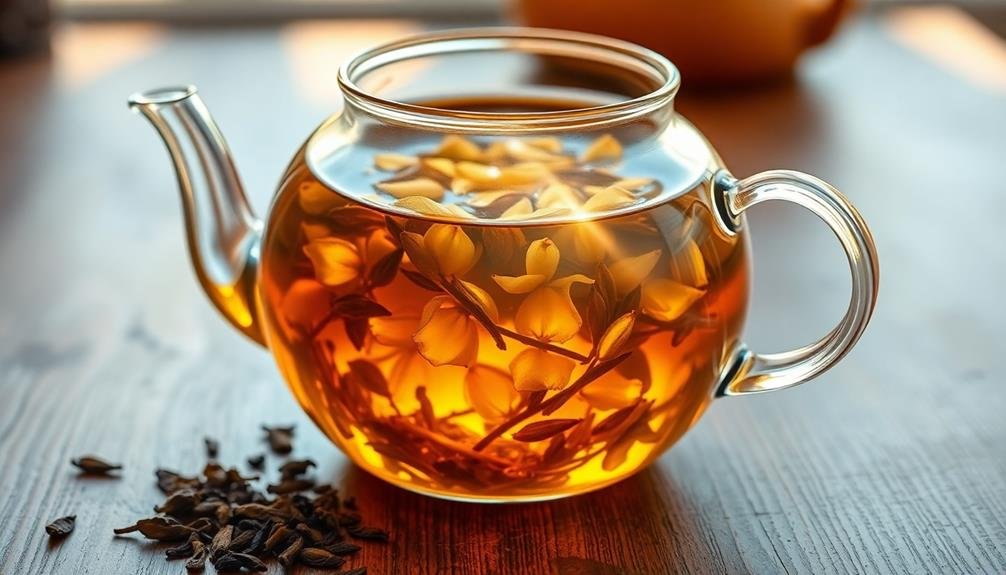
Many tea enthusiasts are drawn to transparent teapots for their unique ability to showcase the brewing process. With these clear vessels, you'll witness the mesmerizing dance of tea leaves as they unfurl and release their flavors. You can observe the water's transformation, from crystal clear to rich amber or vibrant green, right before your eyes.
Transparent teapots allow you to monitor the brewing time visually, ensuring you achieve the perfect strength for your taste. You'll appreciate the subtle color changes that indicate when your tea is ready to be served. This visual cue is especially helpful for delicate teas that require precise timing to avoid bitterness.
Beyond practicality, transparent teapots add an element of elegance to your tea ritual. They're perfect for entertaining guests, as the brewing spectacle becomes a conversation starter. You can showcase the beauty of flowering teas, watching as they blossom into intricate shapes.
The clarity of these teapots also highlights the quality of your tea leaves, letting you admire their form and color throughout the brewing process. By choosing a transparent teapot, you'll elevate your tea experience to a visual feast.
Choosing the Right Glass Teapot
While transparent teapots offer a mesmerizing brewing experience, selecting the right one for your needs is key. Consider factors like size, material quality, and design features when making your choice. Look for borosilicate glass, which is heat-resistant and durable, guaranteeing your teapot withstands temperature fluctuations.
Size matters: Choose a teapot that aligns with your typical serving needs. A 400-600ml capacity is ideal for personal use or small gatherings, while larger sizes suit entertaining. Pay attention to the spout design, as it affects pouring precision. A well-designed spout prevents drips and guarantees a smooth pour.
Consider these features when selecting your glass teapot:
| Feature | Benefit | Example |
|---|---|---|
| Removable infuser | Easy cleaning | Stainless steel mesh |
| Wide opening | Simple filling and cleaning | 3-inch diameter lid |
| Heat-resistant handle | Comfortable pouring | Bamboo or silicone grip |
Don't forget to examine the lid fit. A snug lid helps retain heat and prevents spills. Some teapots come with a warmer, which can be useful for maintaining ideal brewing temperature. By carefully considering these factors, you'll find a glass teapot that enhances your tea experience visually and functionally.
Types of Transparent Teapots
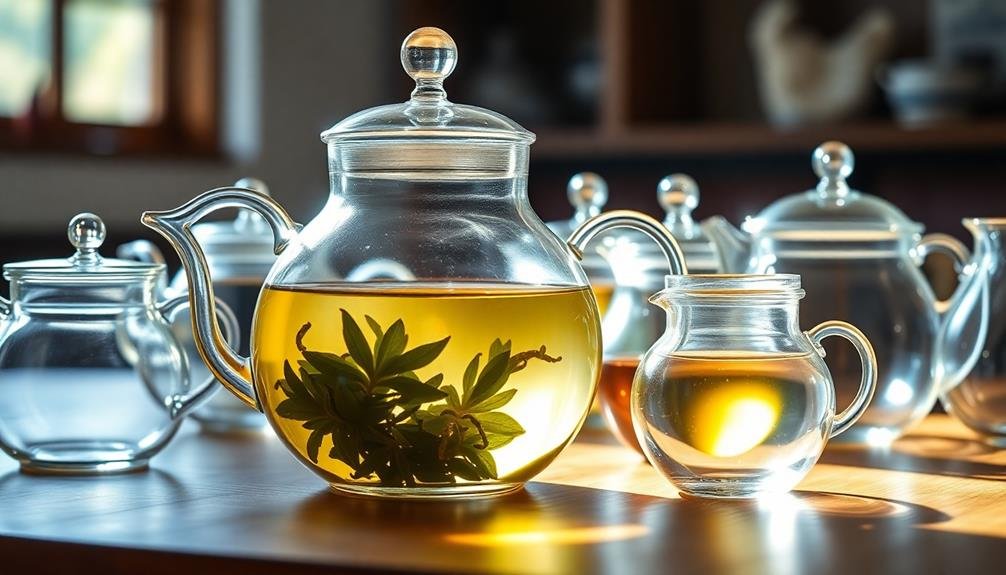
Variety characterizes the world of transparent teapots, offering options to suit every tea lover's preferences.
You'll find several types of transparent teapots on the market, each with unique features and benefits.
Glass teapots are the most common and versatile. They're made from heat-resistant borosilicate glass, allowing you to watch your tea steep and enjoy its color. Some glass teapots come with built-in infusers, while others are designed for loose-leaf brewing.
Plastic teapots offer a lightweight, shatter-resistant alternative. They're often more affordable and come in various shapes and sizes. However, they may not retain heat as well as glass or ceramic options.
Double-walled glass teapots provide excellent insulation, keeping your tea hot for longer periods. They're perfect for those who enjoy a prolonged tea-drinking experience.
Crystal teapots add a touch of elegance to your tea service. While more delicate and expensive, they're prized for their clarity and brilliance.
Lastly, hybrid teapots combine transparent elements with other materials like ceramic or stainless steel. These offer a balance of aesthetics and functionality, often featuring transparent bodies with opaque handles or lids for improved heat retention and durability.
Visual Appeal of Blooming Teas
Beyond their delicious taste, blooming teas offer a mesmerizing visual spectacle that's best appreciated in a transparent teapot. As you pour hot water over the tightly bound tea ball, you'll witness a fascinating transformation. The leaves slowly unfurl, revealing intricate designs and vibrant colors that dance before your eyes.
Blooming teas come in various styles, each with its unique visual appeal:
| Style | Appearance | Flavor Profile |
|---|---|---|
| Jasmine Peony | White petals, green leaves | Light, floral |
| Lily Fairy | Pink lily, green base | Sweet, aromatic |
| Thousand-Day Red | Red amaranth, green tea | Bold, fruity |
| Golden Lotus | Yellow chrysanthemum, green tea | Mellow, earthy |
You'll find that the visual experience enhances your tea-drinking ritual, engaging multiple senses simultaneously. The slow unfurling process creates anticipation, making each sip more rewarding. As you watch the bloom develop, you'll appreciate the craftsmanship involved in creating these edible works of art. Transparent teapots not only showcase the beauty of blooming teas but also allow you to monitor the steeping process, ensuring the perfect brew every time.
Monitoring Steeping Time Effectively
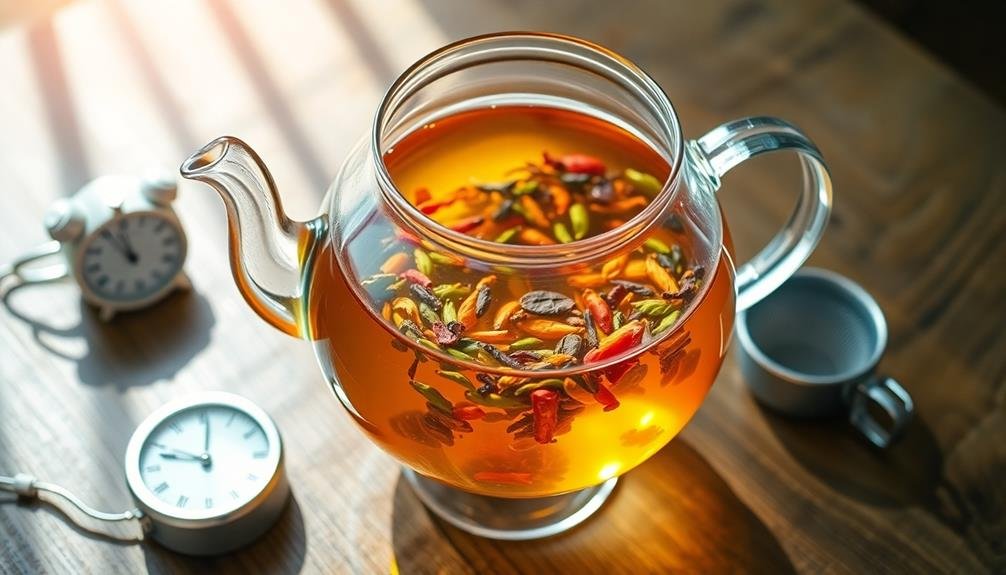
Transparent teapots offer more than just visual appeal; they're invaluable tools for monitoring steeping time. With a clear view of your tea leaves, you can easily observe the color and intensity of your brew as it develops. This visual feedback allows you to achieve the ideal steep every time, tailoring the strength to your personal preference.
By watching your tea steep, you'll learn to recognize the subtle changes that indicate when it's ready. You'll notice how different types of tea infuse at various rates, helping you fine-tune your brewing technique. This hands-on approach enhances your understanding of tea preparation and allows you to experiment with precision.
- Observe color changes in real-time
- Prevent over-steeping and bitterness
- Learn ideal steeping times for different teas
- Adjust strength based on visual cues
Using a transparent teapot also eliminates the need for timers or guesswork. You'll develop an intuitive sense of when to remove the leaves, resulting in consistently delicious cups of tea.
Whether you're a casual tea drinker or a connoisseur, this visual method of monitoring steeping time will elevate your tea experience and help you perfect your brewing skills.
Colorful Infusions on Display
You'll marvel at the visual appeal of brewing tea in a transparent teapot, watching the leaves dance and unfurl before your eyes.
As you observe the leaf expansion, you'll gain insight into the quality and characteristics of your chosen tea.
The color transformation showcase allows you to track the steeping progress, from the initial pale hues to the rich, vibrant tones of a perfectly brewed cup.
Visual Appeal of Brewing
With transparent teapots, you're treated to a mesmerizing display of color as your tea brews.
Watch as the water transforms, taking on hues ranging from pale yellows to deep ambers and rich reds. This visual journey adds an extra layer of enjoyment to your tea-drinking experience, engaging your senses even before the first sip.
The brewing process becomes a fascinating spectacle, allowing you to observe the tea leaves unfurl and release their flavors.
You'll gain a deeper appreciation for the art of tea-making as you witness the intricate dance of leaves and water. Transparent teapots also help you judge the strength of your brew, ensuring you achieve the perfect cup every time.
Here's what you can expect from the visual brewing experience:
- Gradual color changes as flavors infuse
- Mesmerizing swirls and patterns as leaves circulate
- Subtle differences in opacity as the brew strengthens
- A clear view of the tea's texture and consistency
Leaf Expansion Observation
As you watch your tea steep in a transparent teapot, you'll witness a fascinating display of leaf expansion. Dried tea leaves unfurl and dance in the hot water, gradually releasing their flavors and colors. This visual transformation adds an extra dimension to your tea-drinking experience, allowing you to appreciate the artistry of the process.
Different tea types offer unique expansion patterns. Whole leaf teas, like oolong or green tea, put on an impressive show as they slowly uncurl and float gracefully. You'll notice how some leaves sink while others rise, creating a mesmerizing ballet in your teapot.
Herbal blends often feature a vibrant mix of colors, with flower petals and fruit pieces swirling alongside tea leaves.
The leaf expansion process also serves as a practical indicator of brewing time. You'll learn to gauge when your tea has reached ideal strength by observing the fully unfurled leaves. This visual cue helps you avoid over-steeping and achieve the perfect brew consistently.
Furthermore, watching the leaves expand can deepen your appreciation for the tea's origin and production methods, connecting you more intimately with your beverage.
Color Transformation Showcase
Beyond the enchanting leaf dance, transparent teapots offer a stunning visual journey through color. As you brew your favorite teas, you'll witness a mesmerizing transformation unfold before your eyes. The clear glass or plastic allows you to observe the gradual infusion process, turning water into a vibrant, flavorful elixir.
Watch as delicate green teas paint the water with soft, pale hues, while bold black teas create deep amber tones. Herbal infusions produce an array of colors, from soothing lavenders to bright crimsons. This visual feast isn't just aesthetically pleasing; it's also a practical way to gauge your tea's strength and readiness.
- Rooibos: Witness the water turn a rich, reddish-brown
- Butterfly pea flower: Marvel at the magical shift from blue to purple
- Hibiscus: Observe the transformation to a vivid crimson
- Matcha: See the powder disperse into a lush, opaque green
The color showcase doesn't end with the brewing process. As you pour your tea, you'll appreciate the interplay of light and liquid, creating a fascinating display in your cup.
This visual element adds depth to your tea-drinking experience, engaging your senses beyond just taste and smell.
Proper Care for Glass Teapots
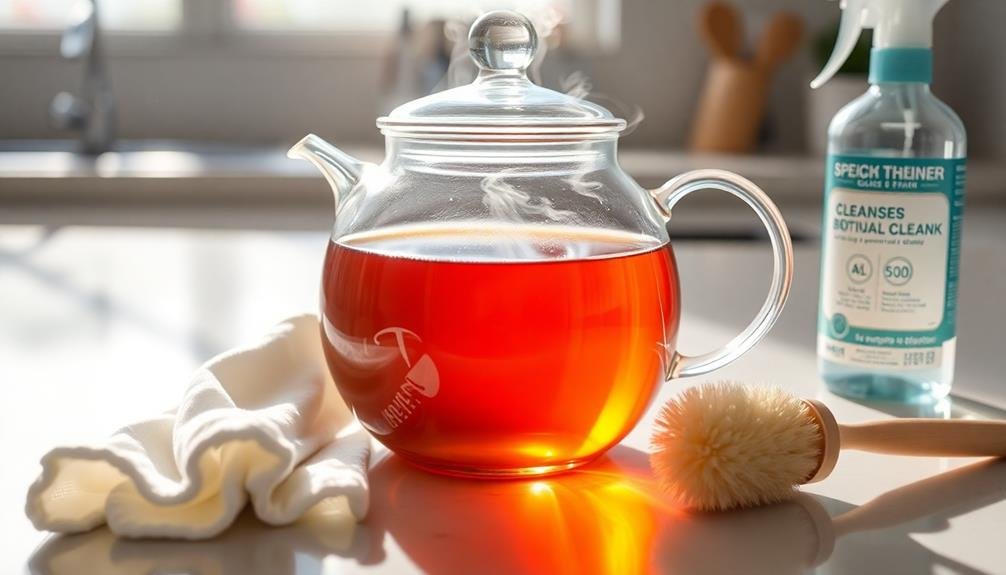
Although glass teapots are beautiful and functional, they require special care to maintain their transparency and durability. To keep your glass teapot in pristine condition, always handle it gently and avoid sudden temperature changes. Rinse it with warm water before use, and don't pour boiling water directly into a cold teapot to prevent cracking.
After each use, clean your teapot thoroughly with mild dish soap and warm water. Avoid using abrasive sponges or harsh chemicals that could scratch or damage the glass. For stubborn stains, create a paste with baking soda and water, apply it to the affected areas, and rinse thoroughly.
To prevent mineral buildup, descale your teapot regularly using a mixture of equal parts white vinegar and water. Let it soak for an hour, then rinse well.
Dry your teapot completely before storing to prevent water spots and mold growth.
Store your glass teapot in a safe place, away from other kitchen items that could potentially chip or crack it.
Temperature Considerations for Glass Brewing
Temperature plays an essential role in brewing tea with glass teapots. When using a transparent vessel, you'll need to be mindful of how heat affects both the glass and your tea. Glass teapots can withstand high temperatures, but sudden temperature changes may cause them to crack or shatter. To prevent this, always preheat your glass teapot by rinsing it with warm water before adding hot water for brewing.
Different teas require specific water temperatures for ideal flavor extraction. Here are some general guidelines:
- Green and white teas: 160-175°F (70-80°C)
- Oolong teas: 180-190°F (82-88°C)
- Black teas: 200-212°F (93-100°C)
- Herbal infusions: 212°F (100°C)
Using a thermometer or electric kettle with temperature control can help you achieve the right temperature for your chosen tea.
Remember that glass teapots cool faster than ceramic or metal ones, so you may need to adjust your brewing time accordingly. If you're serving tea over an extended period, consider using a tea warmer to maintain the desired temperature.
Pairing Teapots With Herbal Blends
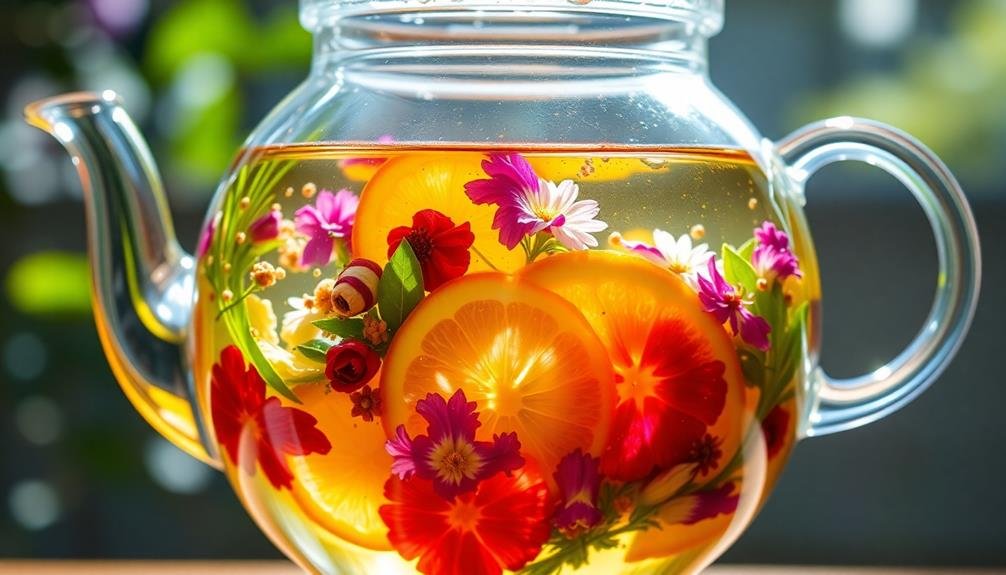
While glass teapots are versatile, they're particularly well-suited for brewing herbal blends. The transparency allows you to appreciate the visual spectacle of herbs unfurling and infusing the water with vibrant colors. When pairing your glass teapot with herbal blends, consider both aesthetics and flavor profiles.
Opt for visually striking herbs like butterfly pea flower, which turns water a brilliant blue, or hibiscus, which creates a deep red infusion. Chamomile's delicate yellow petals and lavender's purple buds offer subtle beauty. For a more dynamic display, try blends with varying leaf sizes and shapes, such as lemongrass, rose hips, and mint.
Consider the teapot's size when selecting your blend. Larger pots accommodate whole-leaf teas and chunky herbal mixtures, while smaller ones are ideal for finely cut herbs. Remember that some herbs, like mint and lemon balm, can be overpowering, so use them sparingly.
To enhance your experience, choose herbs that complement each other in both appearance and taste. Experiment with combinations like rose petals and green tea, or orange peel and cinnamon sticks.
The glass teapot becomes your canvas, allowing you to create visually stunning and flavorful herbal infusions.
Showcasing Layered Tea Creations
Glass teapots offer a unique opportunity to showcase layered tea creations, transforming your brewing process into a visual art form. You'll be able to create stunning tea compositions that delight both the eyes and the palate. By carefully layering different tea types, herbs, and flowers, you can craft a spellbinding display that unfolds as the water is added.
To create enchanting layered tea compositions, consider these elements:
- Color contrast: Combine teas with different hues for visual impact
- Texture variety: Mix larger leaves with smaller ones and add flower petals
- Density differences: Layer lighter ingredients on top of denser ones
- Flavor progression: Arrange layers to create an evolving taste experience
Start by placing heavier ingredients like black tea leaves at the bottom of your glass teapot. Then, add lighter elements such as green tea, followed by delicate flower petals or herbs on top.
As you pour hot water over your creation, watch as the layers begin to dance and intermingle, releasing their flavors and colors into the brew. This process not only enhances your tea-drinking experience but also provides a mesmerizing visual show for you and your guests to enjoy.
Entertaining Guests With Visual Brewing
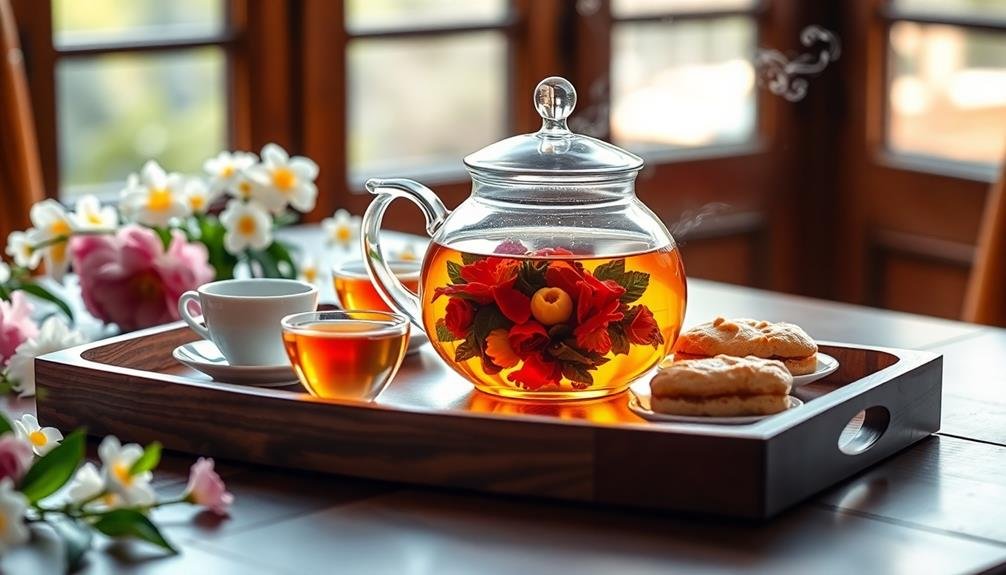
Transparent teapots aren't just for personal enjoyment—they're also a fantastic way to entertain guests. When you're hosting a tea party or gathering, these clear vessels become the centerpiece of your brewing performance. You can captivate your audience as they watch the leaves unfurl and the water transform into a rich, colorful brew.
Start by selecting visually appealing teas like flowering varieties or those with unique shapes. As you pour hot water over the leaves, encourage your guests to observe the intricate dance of flavors being released. Explain the brewing process, pointing out how the color deepens and the aroma intensifies over time.
For an interactive experience, let your guests time the steeping process themselves. They'll appreciate the precision required to achieve the perfect cup. You can also create a tea tasting session, brewing different varieties side-by-side in multiple transparent teapots. This allows your guests to compare colors, aromas, and flavors simultaneously.
Don't forget to share interesting facts about each tea's origin and production methods. By turning tea brewing into a visual spectacle, you'll create a memorable and engaging experience for your guests.
Photographing Your Tea Journey
You'll find transparent teapots are ideal for capturing your tea's color evolution through photography.
Try experimenting with artistic compositions, placing your teapot against contrasting backgrounds or incorporating tea accessories for visual interest.
Proper lighting is essential, so position your setup near a window for natural light or use soft, diffused artificial lighting to highlight the tea's hues and the teapot's gleaming surface.
Capturing Tea Color Changes
One of the most enchanting aspects of using a transparent teapot is the ability to witness your tea's color transformation. As you watch your tea steep, you'll notice subtle changes in hue and intensity that reflect the brewing process.
This visual journey adds a new dimension to your tea experience, allowing you to appreciate the artistry of tea-making fully.
To capture these mesmerizing color changes, consider the following tips:
- Use natural light when possible for the most accurate color representation
- Experiment with different angles to showcase the tea's transparency
- Focus on the contrast between the tea and the teapot's clear walls
- Try time-lapse photography to document the entire steeping process
When photographing your tea's color evolution, pay attention to the initial pale hues that gradually deepen and intensify.
You'll notice how different tea varieties produce unique color profiles, from the golden tones of green tea to the rich amber of black tea.
By documenting these changes, you're not only creating beautiful visual content but also developing a deeper understanding of your favorite brews.
You'll soon find yourself anticipating the precise moment when your tea reaches its perfect color and flavor.
Artistic Teapot Composition Tips
Capturing the beauty of your tea journey goes beyond documenting color changes. To create visually stunning compositions with your transparent teapot, consider these artistic tips:
First, experiment with lighting. Natural light from a window can create soft, ethereal effects, while directional lighting can highlight the teapot's curves and the tea's hues. Try backlighting to make the liquid glow or side lighting to emphasize textures.
Next, focus on composition. Use the rule of thirds to place your teapot off-center for a more dynamic image. Incorporate complementary elements like tea leaves, cups, or a serving tray to tell a story.
Don't forget about negative space – it can add balance and draw attention to your subject.
Pay attention to your background. A simple, uncluttered backdrop will keep the focus on your teapot. Consider using textured surfaces like wood or marble for added visual interest.
Lighting for Tea Photography
Lighting plays an essential role in tea photography, elevating your images from simple snapshots to enchanting visual stories.
When photographing transparent teapots, proper lighting can accentuate the delicate details and showcase the tea's rich colors. Natural light is often the best choice, so position your setup near a window for soft, diffused illumination.
If you're working with artificial light, use a combination of soft boxes and reflectors to create a balanced, even light that minimizes harsh shadows.
Experiment with backlighting to highlight the tea's translucency and create a warm, inviting glow. You'll want to adjust your camera settings to capture the subtle nuances of the tea and teapot. Use a wider aperture for a shallow depth of field, focusing on specific details while blurring the background.
Consider these lighting techniques to enhance your tea photography:
- Side lighting to emphasize texture and form
- Rim lighting for a dramatic silhouette effect
- Low-key lighting for a moody, intimate atmosphere
- High-key lighting for a bright, airy feel
Mindful Tea Rituals Through Transparency
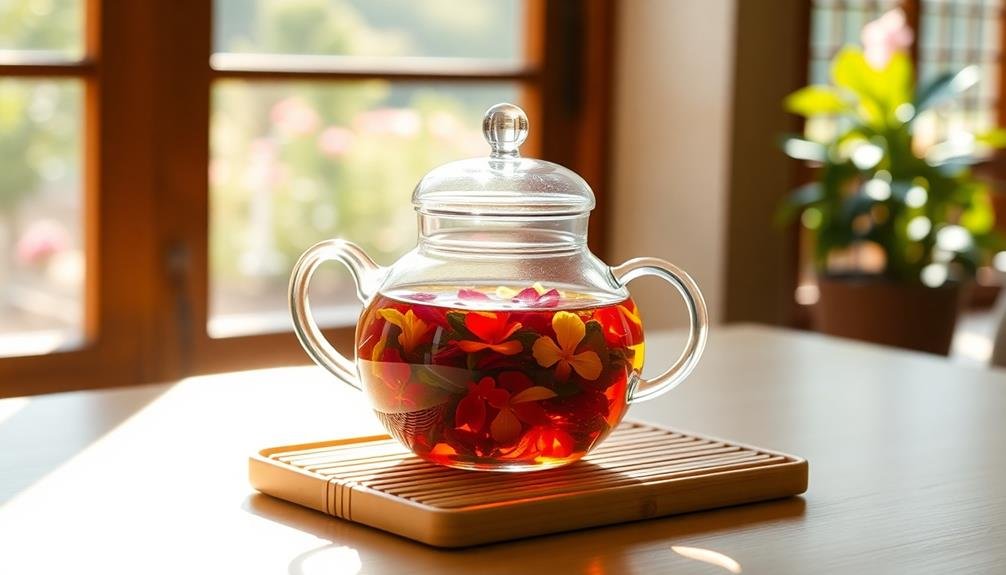
How can a simple transparent teapot transform your tea-drinking experience into a mindful ritual? By allowing you to observe the entire brewing process, a clear teapot engages your senses and encourages a more present and attentive approach to tea preparation.
As you watch the leaves unfurl and release their colors and flavors, you'll become more aware of the subtle changes occurring within the pot. This visual connection helps you tune into the present moment, fostering a sense of calm and focus.
You'll naturally pay more attention to water temperature, steeping time, and the tea's evolving hue, leading to a more precise and enjoyable brew. The transparency also allows you to appreciate the beauty of the leaves' dance, turning your tea preparation into a meditative practice.
You can use this time to set intentions, practice gratitude, or simply breathe deeply and relax. By incorporating a transparent teapot into your routine, you're creating a mindful pause in your day, transforming a simple act of brewing tea into a rejuvenating ritual that nourishes both body and mind.
Frequently Asked Questions
Are Transparent Teapots Safe for Use With Boiling Water?
Yes, you can safely use transparent teapots with boiling water. They're typically made of heat-resistant materials like borosilicate glass. However, you should still handle them carefully to avoid burns and sudden temperature changes that could cause cracking.
Can Transparent Teapots Be Used on Stovetops or Induction Cookers?
You shouldn't use most transparent teapots on stovetops or induction cookers. They're typically made of glass or plastic, which can't withstand direct heat. Instead, boil water separately and pour it into the teapot for brewing.
Do Transparent Teapots Affect the Taste of Tea Differently Than Ceramic Ones?
You'll find that transparent teapots don't notably affect tea taste compared to ceramic ones. They're typically made of glass or heat-resistant plastic, which are neutral materials. However, you might notice subtle differences in heat retention and brewing speed.
How Long Do Transparent Teapots Typically Last With Regular Use?
You'll find that transparent teapots can last 2-5 years with regular use. However, their lifespan depends on the material quality and how you care for them. With proper maintenance, they might even serve you longer.
Are There Any Teas That Should Not Be Brewed in Transparent Teapots?
You can brew most teas in transparent teapots, but be cautious with light-sensitive teas like green and white varieties. They might lose flavor and nutrients faster. It's best to use opaque pots for these delicate teas.
In Summary
You've explored the enchanting world of transparent teapots and discovered how they can transform your tea experience. By embracing these clear brewers, you'll enhance your visual enjoyment, perfect your steeping techniques, and create stunning presentations. Whether you're entertaining guests or savoring a quiet moment alone, transparent teapots offer a unique way to connect with your tea. So go ahead, pour yourself a cup, and watch as your tea unfolds in all its transparent glory.





Leave a Reply